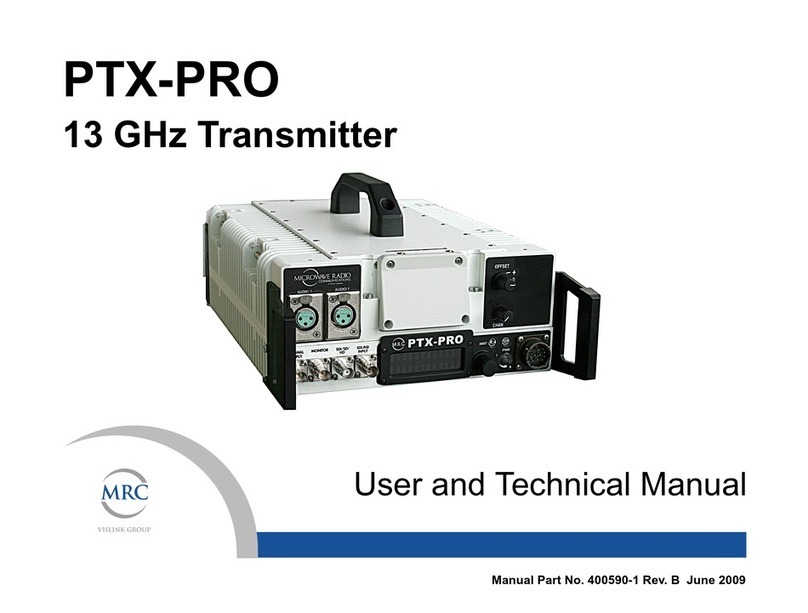NOTE TO USER iiiMTX5000 User and Technical Manual
• Press the power switch to on, perform “Select Preset” on
page 3-24 to select the proper Preset.
•“Perform PA Voltage Adjust Setup” on page 3-44 and then
verify proper transmitter operation by transmitting and
receiving.
RF Levels Too High
If the transmitted RF levels are too high, “Perform RF Level
Adjust” on page 3-49.
Software Recovery
If the software becomes corrupted, the MTX5000 IDU will
attempt to self-recover the software. During the software self-
recovery, the previously configured parameters may be
recovered - not the latest parameters. This may happen if a fault
occurs when installing software updates.
If the software becomes corrupted, press the power switch to off,
wait 10 seconds minimum, and press the power switch to on.
The internal processor will attempt to perform a self-recovery of
the software.
• During the software recovery attempt, a progress bar will
be displayed on the color LCD display panel indicating the
progress of the recovery process. This progress bar may
take considerably more time to reach 100% than during a
normal power up.
• Do not become impatient during the software
recovery process due to the time it may take for
recovery. Do not remove and reapply power while the
progress bar is displayed during the software
recovery process. Software corruption will occur!
• When the power up is complete and the Main screen is
displayed on the color LCD display panel, you may need
to perform “Select Preset” on page 3-24. Then verify
proper transmitter operation by transmitting and receiving.
If the software is no longer corrupted, perform “Firmware
Update” on page 5-114 to verify that you have the latest software
installed in your MTX5000 IDU. Update the software, as
required.
If the software is corrupted or if the Main screen is not displayed,
contact MRC Technical Support for assistance.
Color Bar Generator Operations
All MTX5000 Indoor Units (IDU) contain a built-in digital Color
Bar Generator (CBG) as standard equipment. The IDU is also
available with an optional analog CBG. Potential operator
problems can occur when using the optional analog CBG or the
built-in digital CBG.
Potential operator-induced problems may include the following:
• Selection of the CBG On operating mode during test,
troubleshooting, or CBG setup and failure to select the
Off, A Gen, or A Stby operating mode for normal
operation when test, troubleshooting, or CBG setup is
completed.
• Selection of the CBG On, A Gen, or A Stby operating
mode when the optional Analog Color Bar Generator is
not installed in the MTX5000 IDU.
To avoid potential operator problems that can impact operation
of the MTX5000 System, the following information is provided:
• The optional analog CBG and the digital CBG both
include Off, On, A Gen (Auto Generated), or A Stby
(Auto Standby) operating mode options.
• The CBG mode should only be set to the On operating
mode for test, troubleshooting, or for setup of the




























